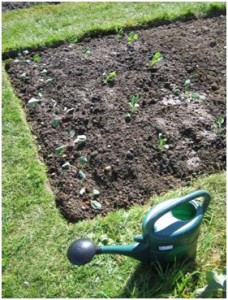Ten Tips for Grow Your Own Beginners
1. Don’t throw anything away.
Become a hoarder. If I had a pound for every time I said ‘damn, I wish I hadn’t thrown that away,’ I’d have enough money to buy a greenhouse. When I got my plot, I came in, all guns a blazin’, and threw out a big metal barrel because it had a load of muck festering in the bottom. It would have been perfect for bonfires. I miss that barrel.
 2. Nurture what you inherit.
2. Nurture what you inherit.
If the previous occupant had already planted anything on the allotment, take care of it. Sounds obvious, but I had an overwhelming temptation to rip everything out and make my own mark from the start. Thankfully, I left well alone and got oodles of purple sprouting broccoli and an early crop of onions. I also pruned some ropey old gooseberry bushes which subsequently cropped heavily, as well as getting a bag full of plums from a dead-looking tree I was ready to hack down.
3. Don’t plan
Just plant. Plans are for next year. Buy some seeds, follow the instructions on the back, and get it planted. Some worked for me and some didn’t, but I got a great idea of how to grow vegetables, what area of my plot gets the most sun and other knowledge that proved invaluable in my second year.
And boy was I proud of what I did manage to grow.
4. Plant easy to manage stuff
Ease yourself in gently. I grew cauliflowers and aubergines, which all died pretty quickly, leaving me deflated. Fortunately I was saved by the onions, curly kale, garlic, lettuce and perpetual spinach. These all grew well without having to spend every waking hour watering and tending them.
5. Grow tomatoes and strawberries
If I ever needed convincing that your own food dramatically outstrips the taste of shop bought alternatives, then tomatoes and strawberries are the crop to do it. The tomatoes are like sweets, and there is a divine taste to home grown strawberries that can’t be matched unless freshly picked from the plot
Even if everything else failed, it’d be worth it just for these.
 6. Grow veg that’s expensive to buy
6. Grow veg that’s expensive to buy
One thing I’ve noticed is how cheap some veg is compared to others. If you’re short on space, a butternut squash at £1.67 a kilo is a bargain hunter’s dream when considering most packets contain about 10 seeds, while potatoes take up a lot of room for a 40p saving every 500g.
7. Talk to the old boys
There’s every chance that the same people have been working your neighbouring plots for years. They’ll be the ones who can tell you what grows well on the site, what to avoid, and all the other tricks that will get you on your way. From my experience, allotmenteerists are a lovely bunch, and they’ll only be too happy to help.
8. Join a web forum
Need help and don’t know where to go? Online web forums are full to bursting with knowledgeable gardeners. Register, post a question, and an hour later you’ll have several suggestions on how to solve your problem. www.growfruitandveg.com/grapevine is a nice, easy to use forum with lots of friendly, experienced posters.
9. Grow veg you like
Again, sounds obvious, but if you fought with your mum over eating sprouts, then don’t bother growing anything you’re not going to eat – as tempting as it is to deck the whole plot out with every vegetable under the sun!
10. Start a blog and take lots of photos!
This didn’t help me learn what I was doing, but my plot has changed so much over the last four summers that it’s incredibly rewarding and entertaining to look back at the differences. Starting a blog is a great way of sharing that with other growers from all over the world, as well as keeping a record of things that worked, and things that didn’t.
I’d love to hear how you’re getting on!
